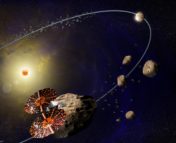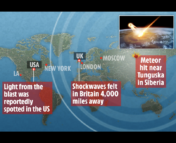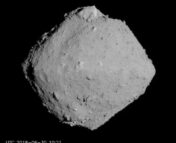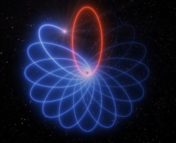This guest post was written by Alexander Iamartino, an undergraduate student at the University of Connecticut, as part of the Fall 2019 Foundations of Modern Astrophysics class taught by Professor Cara Battersby. Alex is an Engineering Physics major and is looking to pursue a career in astrophysics following completion of his undergraduate degree. Aside from astrophysics, he enjoys playing soccer, competing in disc golf tournaments, and practicing archery.
Pretend for a moment that you are a Tyrannosaurus Rex, living some 66 million years ago. You are the alpha predator, unrivaled in strength and intelligence, and you rule over a vast rainforest near the ocean. While feasting on a vanquished sauropod, you look to the sky to see a massive flaming sphere barreling towards the ocean. You watch as it crashes into the Earth. Had you survived the immediate impact effects, such as the 100-meter-tall mega tsunami, the ensuing famine and global winter would have surely claimed you (and 75% of all life on Earth). With this scenario in mind, consider the question: what is preventing an apocalyptic event like this from happening again?
We now know destructive events, like the one that killed the dinosaurs, are caused by asteroids and other celestial objects crashing into Earth. NASA’s Jet Propulsion Laboratory (JPL) and the Center for Near Earth Object Studies (CNEOS) officially define the various categories of objects that come in close proximity to Earth. A Near-Earth Object (NEO) is any small celestial body whose closest approach to the Sun is 1.3 AU. This definition is further divided into subcategories, such as Near-Earth comets (NEC), Near-Earth asteroids (NEA), and Potentially Hazardous Asteroids (PHA).
Recent Close Calls
In recent years, we’ve had some close calls with Near-Earth Objects. The Chelyabinsk meteor in Russia is one notable example of a recent NEO, making headlines in 2013; 1,500 people had to seek medical attention due to effects from its blast. This was later identified to have originated from an Apollo-Class NEA. This class of asteroid is the most abundant in our solar system, and makes up the largest portion of potentially hazardous asteroids.
Another asteroid, 2019 TW1, was observed three days before it flew past Earth last October. Although this object was only ten to fifteen meters in size, it could have created a considerable amount of damage had it passed through our planet’s atmosphere and survived entry. This size of object is estimated to produce an airburst, an upper atmosphere explosion, with kinetic energy equivalent to 82 kilotons of TNT, enough to shatter windows and cause moderate damage to urban buildings.
Assessing Risk from NEOs
Speaking of damage, it is important to understand how risk assessment works with NEOs. Presently, there are two scales that are used to identify how hazardous these objects are in terms of localized, regional, or global devastation potential. The scales used are called the Torino scale and the Palermo Technical Impact Hazard scale. The Torino scale is more qualitative and is used for conveying the severity of an event to the media and the general public. This scale has color-coded designations ranging from 0 to 10, with 10 being a globally catastrophic event.
These values are based upon impact probability and the kinetic energy of the object. On the other hand, the Palermo scale is used more on the technical side of astrophysics. This scale is logarithmic, and bases its ratings on the average risk posed by an object of a particular size. Both of these scales help to identify which objects may need to be observed more closely. Observations of NEOs are conducted by numerous parties from around the globe. In the United States, the NEO Observations Program is a government-mandated objective given primarily to NASA and research institutions, intended to characterize a large portion of NEOs.
This is done mainly using two telescopes – the Wide-field Infrared Survey Explorer (WISE) space telescope and the Infrared Telescope Facility located at the Mauna Kea Observatory in Hawaii. Other smaller U.S. telescopes also contribute to this search. On the international level, contributors to the search for these objects include nations such as Chile, Australia, South Africa, the UK, China, Spain, Israel and many others. All of these observatories report findings to the International Astronomical Union’s (IAU) Minor Planet Center. This organization classifies, organizes, and studies minor bodies in our solar system.
Recently introduced in September 2019, NASA’s Planetary Defense Coordination Office announced the inception of the NEO Surveillance Mission, which provides a new $600 million dollar telescope dedicated to the search for NEOs. This scope will be launched into space by the end of 2025, and will be stationed at the L1 Lagrange Point. This location is a point in space where the gravitational forces of the Sun and Earth allow for a small object to remain in a relatively constant position. The point L1 is conducive to inner solar system observations and surveys, as its viewing is unobstructed.
Similar to its predecessor scopes, it will be observing in the infrared range of light. This wavelength is ideal for asteroid and comet detection. As we have already learned in the case of 2019 TW1, some asteroids are difficult to detect due to their size and how dim they are in visible light. But, passing by the Sun means that some of these objects warm to the point where they are readily detected with infrared optics.
What if an asteroid threatens Earth?
We know how to detect these objects, but what would happen if NASA was alerted of an asteroid on a collision course with Earth? Numerous theoretical exercises have been put to the test by planetary defense groups from around the world to prepare for this exact event. One such simulation was the 2019 PDC Hypothetical Asteroid Impact Scenario. This mock event takes the reader day by day through a hypothetical detection. It discusses the ensuing press releases to the public, as well as the calculated deflection criteria required to save the planet.
The primary method of deflection used in most scenarios is kinetic impact. An impactor spacecraft would be launched as soon as possible and would be set to collide with the threatening asteroid. This method is going to be tested in a real situation under the Double Asteroid Redirection Test (DART) mission in 2022. An impactor spacecraft is going to attempt to deflect a binary asteroid system. The spacecraft will crash into a small asteroid orbiting a larger host, in an attempt to change the object’s orbital period. This test will safely take place 11 million kilometers from Earth, and will be closely observed by numerous ground-based telescopes.
Other methods of deflection have been proposed such as atomic bomb detonation, solar sails, and gravitational tractoring, but these methods have yet to be tested. In the coming years, we are likely to see more research in this field.
As you can see, we are in an extremely delicate position when it comes to NEO deflection and impact prevention. While we are able to detect most significant objects, all it takes is one missed observation for a city to be destroyed or for humankind to cease to exist. But fear not, as there are no known significant threats to our planet presently, and this area of study is growing thanks to our continued expansion into the cosmos.




